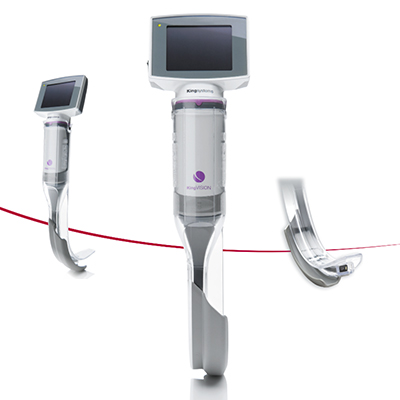A laryngoscope is an optical device that makes it possible for the user to see, observe and diagnose a patient’s upper airways. With this knowledge, a doctor or healthcare provider can better diagnose issues of the larynx, upper airway, and vocal cords, as well as be prepared for surgical operations. A laryngoscope is also used in anesthesiology to assist with the insertion of an endotracheal tube, or ET tube, down the trachea to help the patient breathe, a process known as intubation.
Laryngoscopy is a vital procedure for emergency medical workers in the field when they need to perform an intubation. EMS personnel may encounter any kind of airway emergency in the field: severe injury, asthmatic emergency, or an allergic reaction. Proper visualization of the victim’s vocal cords and ET Tube placement are critical.
The King Vision Video Laryngoscope simplifies these processes by providing the user with a clear picture of the patient’s airway structures and the surrounding soft tissue with its on-board video monitor. Continue reading for detailed information on the King Vision Video Laryngoscope’s features, functions, and accessories.
Direct Laryngoscopy and Indirect Laryngoscopy
There are two types of laryngoscopy that are performed on patients: direct laryngoscopy and indirect laryngoscopy. Direct laryngoscopy is when a clinician directly observes the vocal cords using a laryngoscope equipped with a Macintosh Blade or Miller Blade.
In contrast, indirect laryngoscopy is indirect visualization of the vocal cords using a video camera or other optic device, such as a mirror.
Endotracheal Intubation and Visualization Made Easy
The King Vision Video Laryngoscope is a reusable video laryngoscope for intubation and indirect video laryngoscopy with its built-in imaging technology. The device is ergonomic, lightweight, and fits comfortably in the palm of your hand.
Its design decreases post-intubation or examination discomfort by minimally impacting the soft tissues of the throat, and it also reduces the risk of damaging the patient’s teeth. It is powered by AAA batteries and can be used continuously for up to 90 minutes.
The video aspect ratio on the King Vision display is 4:3 with a crisp resolution of 320 x 240 QVGA with the use of an TFT LCD display. The screen measures 6.1 cm or 2.4 inches diagonal, and features an ABS anti-reflective coating for unobstructed viewing. The video refresh rate is a smooth 30 frames per second. A white LED light on the body of the King Vision Laryngoscope provides ample illumination, and users never have to be concerned with replacing a burned out bulb.
QVGA
QVGA is an abbreviation for “Quarter VGA,” which is a term often used to describe any display with 320 x 240 resolution. QVGA displays were usually found on Personal Data Assistants (PDAs) and handheld video game systems.
QVGA has one quarter of the resolution of the 640 x 480 maximum resolution of the original Video Graphics Array (VGA) display technology originally developed by IBM.
With such a clear picture available, the King Vision Video Laryngoscope is a perfect tool to be paired with a training manikin to be used with intubation training scenarios.
If a larger view is needed in the case of a difficult intubation, the video laryngoscope has an RCA video port for connecting to monitors through the use of a video adapter cable. The non-glare, full color video display is built to withstand repeated cleaning.
The body of the device is constructed of sturdy, lightweight polycarbonate material that is designed for years of use and easy clean up.
Channeled Blade and Non-Channeled Blades
The King Vision Video Laryngoscope’s reusable display system supports different laryngoscope blade types and sizes according to the task at hand. Channeled video laryngoscope blades are specially designed with an additional conduit to guide an ET tube into the trachea. Standard blades can also be utilized, which require the use of an additional stylet to guide the ET tube.
The King Vision Video Laryngoscope’s blades are also designed to be single use and disposable. Disposable blades allow for easy clean up of the device while also cutting down on the risk of cross contamination between appliances.
Ambu and King Systems Help With Difficult Airway Management
The King Vision Video Laryngoscope Kit includes the following: the laryngoscope, video display, storage case, 3 channeled blades, one standard blade, and AAA batteries. The display comes with a one year warranty, and is made in America.
Whether it’s in the emergency room, operating room, or out in the field, the King Vision Video Laryngoscope is ready to help doctors, clinicians, and emergency medical services (EMS) personnel with difficult airway situations when time and having a clear picture are vital. Take away any guesswork when it comes to patient intubation!
To get more information about the King Vision Video Laryngoscope, its accessories, or any other medical equipment, contact Penn Care.



